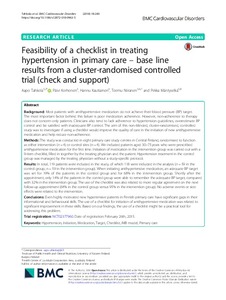Feasibility of a checklist in treating hypertension in primary care – base line results from a cluster-randomised controlled trial (check and support)
Aapo Tahkola; Päivi Korhonen; Hannu Kautiainen; Teemu Niiranen; Pekka Mäntyselkä
https://urn.fi/URN:NBN:fi-fe2021042720394
Tiivistelmä
Background
Most patients with
antihypertensive medication do not achieve their blood pressure (BP)
target. The most important factor behind this failure is poor medication
adherence. However, non-adherence to therapy does not concern only
patients. Clinicians also tend to lack adherence to hypertension
guidelines, overestimate BP control and be satisfied with inadequate BP
control. The aim of this non-blinded, cluster-randomised, controlled
study was to investigate if using a checklist would improve the quality
of care in the initiation of new antihypertensive medication and help
reduce non-adherence.
Methods
The study was conducted in eight primary care study centres in Central Finland, randomised to function as either intervention (n = 4)
or control sites (n = 4). We included patients aged 30–75 years who
were prescribed antihypertensive medication for the first time.
Initiation of medication in the intervention group was carried out with a
9-item checklist, filled in together by the treating physician and the
patient. Hypertension treatment in the control group was managed by the
treating physician without a study-specific protocol.
Results
In total, 119 patients were included in the study, of which 118 were included in the analysis (n = 59
in the control group, n = 59 in the intervention group). When
initiating antihypertensive medication, an adequate BP target was set
for 19% of the patients in the control group and for 68% in the
intervention group. Shortly after the appointment, only 14% of the
patients in the control group were able to remember the adequate BP
target, compared with 32% in the intervention group. The use of the
checklist was also related to more regular agreement on the next
follow-up appointment (64% in the control group versus 95% in the
intervention group). No adverse events or side effects were related to
the intervention.
Conclusions
Even highly motivated new
hypertensive patients in Finnish primary care have significant gaps in
their informational and behavioural skills. The use of a checklist for
initiation of antihypertensive medication was related to significant
improvement in these skills. Based on our findings, the use of a
checklist might be a practical tool for addressing this problem.
Kokoelmat
- Rinnakkaistallenteet [19250]
